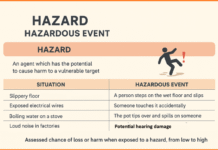Emergency planning is a very important component of organizational safety and resilience. Whether in industrial, commercial, or institutional settings, having a well-developed emergency plan minimizes injury, damage, and downtime. Below are the three essential steps in the emergency planning process:
Contents
1. Identification: Recognize Hazards and Assess Vulnerabilities
The first step in emergency planning is to identify potential hazards that could impact people, property, or operations. These hazards can be natural (earthquakes, floods), technological (chemical spills, power failures), or human-induced (violence, sabotage).
In this phase, it’s also crucial to assess the vulnerabilities of your organization — such as locations with limited exits, critical equipment areas, or departments with high concentrations of personnel. Understanding these weak points helps in prioritizing which risks need immediate attention.
Key activities:
- Conduct hazard identification surveys
- Map out vulnerable areas and assets
- Consult historical incident data
- Include employee input and expert consultations
2. Assessment: Analyze Potential Emergencies and Plan Responses
Once the risks are identified, the next step is to assess the likelihood and impact of various emergency scenarios. This involves examining the most probable and most severe events and creating tailored response plans for each situation.
Risk assessment helps in ranking emergencies from high to low priority and ensures that the plan addresses the worst-case scenarios effectively.
Key activities:
- Perform risk analysis and scenario modeling
- Determine impact on people, property, and operations
- Develop customized response strategies
- Identify necessary resources and roles
3. Control: Build Capacity and Ensure Plan Implementation
The final step is to ensure the organization is prepared and capable of executing the emergency plan effectively. This includes assigning responsibilities, conducting regular training, and ensuring communication and coordination mechanisms are in place.
An emergency plan is only as good as its execution. Regular drills and audits help keep the plan actionable and updated.
Key activities:
- Assign roles and form emergency response teams
- Provide training and conduct mock drills
- Establish communication and control systems
- Monitor, evaluate, and revise the plan as needed
Effective emergency planning is not a one-time task—it is a continuous process of identification, assessment, and control. By recognizing hazards, assessing vulnerabilities, and ensuring organizational readiness, businesses and institutions can respond quickly, minimize damage, and recover faster during emergencies.





